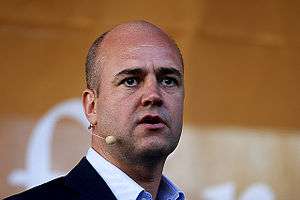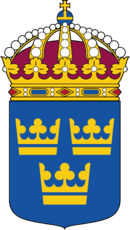Reinfeldt Cabinet
| Fredrik Reinfeldt's cabinet | |
|---|---|
|
52nd cabinet of Sweden | |
 | |
| Date formed | 6 October 2006 |
| Date dissolved | 3 October 2014 |
| People and organisations | |
| Head of government | Fredrik Reinfeldt |
| Deputy head of government |
Maud Olofsson (2006-2010) Jan Björklund (2010-2014) |
| Head of state | Carl XVI Gustaf |
| Number of ministers | 25 |
| Ministers removed (Death/resignation/dismissal) | 17 |
| Member party |
Moderate Party Liberal People's Party Centre Party Christian Democrats |
| Status in legislature |
Coalition majority government (2006-2010) Coalition minority government (2010-2014) |
| History | |
| Election(s) |
2006 election 2010 election |
| Predecessor | Persson's cabinet |
| Successor | Löfven's cabinet |
 |
| This article is part of a series on the politics and government of Sweden |
|
| Foreign relations |
|
Related topics |
The cabinet of Fredrik Reinfeldt was the cabinet of Sweden from 2006 to 2014. It was a coalition cabinet consisting of the four parties in the centre-right Alliance for Sweden: the Moderate Party, Centre Party, Liberal People's Party and the Christian Democrats. The cabinet was installed on 6 October 2006, following the 2006 general election which ousted the Social Democrats after twelve years in power. It retained power after the 2010 general election but now as a minority government, and is the longest-serving consecutive non-social democratic government since Erik Gustaf Boström in 1900. It was led by Prime Minister Fredrik Reinfeldt of the Moderate Party.
Ministers
Party breakdown
Party breakdown of cabinet ministers:
| 13 | |
| 4 | |
| 4 | |
| 3 |
New ministries
- Ministry of Employment, belonged to the Ministry of Industry, Employment and Communications in the cabinet of Göran Persson.
- Ministry of Culture, belonged to the Ministry of Education and Culture in the cabinet of Göran Persson.
- Ministry of Environment was before called the Ministry of Sustainable Development.
- Ministry of Integration and Gender Equality, belonged to the Ministry of Justice and the Ministry for Foreign Affairs in the cabinet of Göran Persson.
Policy of the cabinet
The new government was presented on October 6, 2006. The following reforms have been proposed:
- Communication and transportation:
- Culture:
- The new government plans to reintroduce entrance fees to the country's 21 state-operated museums.[2]
- Third-party liability premiums for vehicle insurance will be raised.[1]
- The current operator's license for the public service broadcasters Sveriges Television, Sveriges Radio and Sveriges Utbildningsradio will come up for renegotiation in three years, instead of six as negotiated with the outgoing government.[3]
- Education:
- Government agencies:
- The following government agencies will be closed down: Swedish Integration Board (Swedish: Integrationsverket), National Institute for Working Life (Swedish: Arbetslivsinstitutet), Swedish Animal Welfare Agency (Swedish: Djurskyddsmyndigheten) and the County Labour Boards (Swedish: länsarbetsnämnderna).[5]
- All agencies are being scrutinized for reformation.
- Heads of agencies to be made into merit based appointments.
- Foreign aid:
- The monetary foreign aid's goal and what countries receiving aid is being reconsidered.
Implemented reforms and legalizations
- Working Tax Cuts
- Considerably raised fees for unemployment funds, linked to the rate of unemployment among the members of each fund (introduced January 2007, abolished January 2014)[6]
- Municipal allowance
- Deduction for household services, so-called RUT deduction
- Abolished compulsory military service
- High Schools reforms and new grading system for the entire school system
- Reforming the legal framework of the National Defence Radio Establishment (FRA)
- Implemented the Enforcement Directive (IPRED)
- Defence Decision 2009
- Abolished pharmaceutical monopoly
- Deregulated railroad traffic[7]
- Radio frequencies for mobile broadband in 800 MHz band[8]
- Liberalisation of the Alcohol Law
- Abolition of the Swedish Cinema Office
- Abolition of compulsory student union[9]
- Deductibility of gifts to nonprofit organizations
- Reforms of the health insurance system
- Decreased restaurant VAT from 25 to 12 percent, to the same level as for any other food.
- Legalization of same-sex marriage
Controversies and resignations
On October 7, 2006, the day after the new cabinet was announced two of the ministers, the Minister for Foreign Trade Maria Borelius and the Minister for Culture Cecilia Stegö Chilò, admitted that they had previously employed persons to take care of their children without paying the appropriate taxes. On October 11, 2006, it came to light that Cecilia Stegö Chilò and her husband had not paid their TV license for the last 16 years. On October 12, 2006, it emerged that two other ministers in the cabinet had neglected to pay the television license; Maria Borelius and the Minister for Migration and Asylum Policy, Tobias Billström.[10] Radiotjänst i Kiruna AB, the private agency tasked with collecting the license fee, filed criminal charges against Cecilia Stegö Chilò, Maria Borelius and Tobias Billström.[11]
On October 14, 2006, Maria Borelius resigned as Minister for Foreign Trade. On October 16, 2006, just two days after Maria Borelius' resignation, Minister for Culture Cecilia Stegö Chilò resigned as well.[12]
The Minister for Defence, Mikael Odenberg, resigned on September 5, 2007, as he thought the budget cuts his department would face were to high.[13]
On March 29, 2012, Minister for Defence, Sten Tolgfors, resigned due of his way to deal with the Project Simoom.
Public perception
In public opinion survey conducted by Aftonbladet/Sifo in late 2006, the Swedish public was asked to rate each of the new ministers on a 5-graded scale. The average result for the 22 ministers was 2.93.[14] This is higher than any of the rates that the Social Democratic Persson cabinet ever received during its years in power, and the highest ratings ever since the surveys started in 1996.[15]
From the Swedish general election, 2006 the opinions for the Reinfeldt cabinet have declined steadily from a level of about 51% down to a level about 40%,[16] which election researchers generally explain as more than what could be expected due to normal inter-election popularity fall. Center-right newspapers in Sweden criticize the cabinet for not being pedagogically proficient, while the opposition newspapers just connects the impopularity of the cabinet with the scandals and the performed practical politics.
References
- 1 2 Tyngre börda för bilismen, Näringsliv24, October 20, 2006 (Swedish)
- ↑ Free museum entry to be abolished (English), The Local, October 11, 2006.
- ↑ Sändningstillstånd kan bli kortare för public service (English), The Local, October 11, 2006.
- ↑ Regeringen stoppar gymnasiereform, Upsala Nya Tidning, October 11, 2006 (Swedish)
- ↑ Fler myndighetsnedläggningar utreds, Svenska Dagbladet, October 23, 2006 (Swedish)
- ↑ Kjellberg, Anders (2009) "The Swedish Ghent system and trade unions under pressure" Transfer no 3-4 2009 (pp. 481–504). ISSN 1024-2589
- ↑ http://www.sweden.gov.se/sb/d/11656
- ↑ http://www.dn.se/debatt/tv-branschens-ensamratt-till-frekvensutrymme-bryts-1.687636
- ↑ http://www.sweden.gov.se/sb/d/11248/a/121230
- ↑ Ministers could be reported to police over TV fee (English), The Local, October 12, 2006.
- ↑ Ministers reported to police for unpaid TV licences (English), The Local, October 13, 2006.
- ↑ Second Swedish minister resigns (English), The Local, October 16, 2006.
- ↑ Odenbergs avgång en protest mot nedskärningar, Dagens Nyheter, September 5, 2007
- ↑ Aftonbladet, January 4, 2007 (not online).
- ↑ Erixon, Dick, "Högsta betyg för svensk regering någonsin", January 10, 2007.
- ↑ Synovate/Temo Opinion research
External links
| Preceded by Persson |
Cabinet of Sweden 2006-2014 |
Succeeded by Löfven |